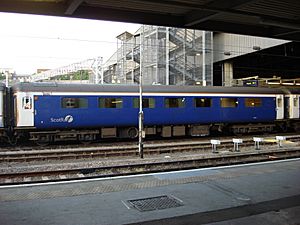British Railways Mark 2 facts for kids
Quick facts for kids British Rail Mark 2 |
|
|---|---|

|
|
| In service | 1964-present |
| Manufacturer | BREL |
| Built at | Derby, England |
| Constructed | 1963 - 1975 |
| Entered service | 1964 |
| Number built | 1,876 |
| Operator(s) | Arriva Trains Wales First ScotRail Network Rail |
| Specifications | |
| Car body construction | Steel Semi-integral |
| Car length | 64 ft 6 in (19.66 m) |
| Doors | Hinged slam, centrally locked |
| Maximum speed | 100 mph (161 km/h) |
| Train heating | Pressure Ventilation Air Conditioning |
| Braking system(s) | Clasp, pneumatic |
| Track gauge | 1,435 mm (4 ft 8 1⁄2 in) |
The British Rail Mark 2 is a type of passenger train carriage. It was the second main design of train cars made by British Rail. These carriages were built to be stronger and safer than the older Mark 1 trains. They were also designed to be more comfortable for passengers.
The Mark 2 carriages were first introduced in 1964. They were built in Derby, England by a company called BREL. Over 1,800 of these carriages were made between 1963 and 1975.
Contents
What is the Mark 2 Train Carriage?
A train carriage is like a passenger car on a train. The Mark 2 was a big step forward for train travel in Britain. It was designed to improve safety and comfort for everyone on board. These carriages could travel at speeds up to 100 miles per hour (160 km/h).
Why Was the Mark 2 Special?
The Mark 2 carriages were special for a few important reasons. They brought new features that made train journeys better. They were also very reliable and lasted a long time.
Stronger Design and Safety
One of the most important improvements was safety. The Mark 2 carriages had a stronger body made of steel. This "semi-integral" design meant the carriage was built as one strong unit. This made them much safer in case of an accident.
Comfort on the Go
Early Mark 2 trains had good ventilation. Later versions, starting in 1971, even had air conditioning. This made journeys much more pleasant, especially on hot days. The doors were also improved, with a central locking system for safety.
Different Versions of the Mark 2
Over the years, the Mark 2 design was updated many times. Each new version added more improvements. These different types are known as Mark 2A, Mark 2B, Mark 2C, Mark 2D, Mark 2E, and Mark 2F.
Mark 2A to 2F Improvements
- Mark 2A: These were similar to the first ones but had some small changes.
- Mark 2B: These introduced better heating and ventilation systems.
- Mark 2C: These had further improvements to the heating.
- Mark 2D: These were the first to have air conditioning as standard.
- Mark 2E and 2F: These were the most advanced versions. They had improved air conditioning and better bogies (the wheel sets) for a smoother ride.
Where Were They Used?
The Mark 2 carriages were a common sight on British railways for many years. Even today, some are still in use! They were operated by British Rail and later by other train companies like Arriva Trains Wales and First ScotRail.
Across the UK and Beyond
Many Mark 2 carriages were also sold to other countries. You could find them in places like New Zealand, Ireland, and even Taiwan. This shows how well-designed and popular they were. They were used for regular passenger services, sleeper trains, and even special charter services.
Images for kids
-
Prototype Mk2 13252 at the Mid-Norfolk Railway in April 2009
-
Mark 2A Tourist Standard Open (TSO) 5278 "Melisande" at Cheltenham Spa on 18 September 2004 on a charter service to Swindon
-
Mark 2 coaches 5174, 5132 and 9102 at the Northampton & Lamport Railway on 26 January 2008
-
Refurbished Mark 2 carriages used on a Metlink Wairarapa Connection service in Wellington, 2014













